A foolproof recipe to make your own, homemade Italian ciabatta bread in under four hours!
You might also like these recipes for Italian bread and Tuscan bread.
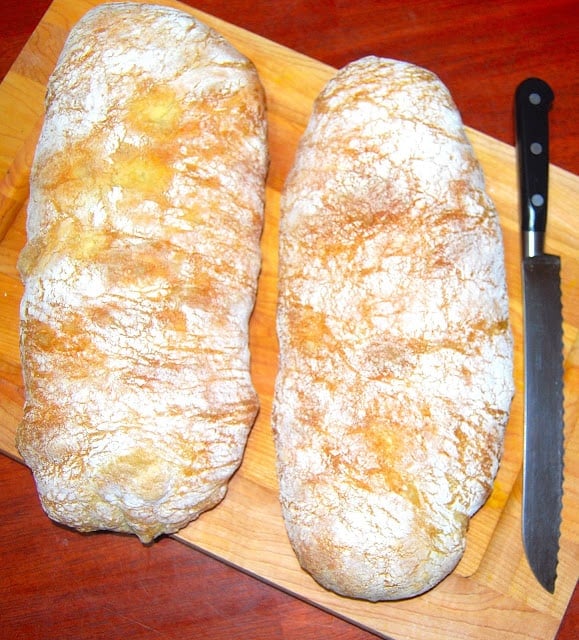
Ciabatta is my favorite Italian bread, but it is not always the easiest and quickest bread to make, even for a seasoned baker.
The dough is rather wet and sticky and can seem impossible to work with when you're new to the process, but that wet stickiness is also vital to the light, bubbly, airy texture of this bread.
This also is a bread that requires some planning ahead because you need to let the starter stand overnight or at least several hours. And planning ahead is not my favorite thing to do.
Would you like to save this recipe?
I was resigned to making ciabatta only when I have the time, which is not often, until I came upon a great technique that cuts down the waiting significantly.
The initial rise time for this ciabatta is under two hours, and the second rise is just about an hour. So in under four hours, including prep and baking time, you are rewarded with a fluffy, crusty, delicious bread that you won't be able to stop dunking in olive oil and popping into your mouth.
More vegan bread recipes
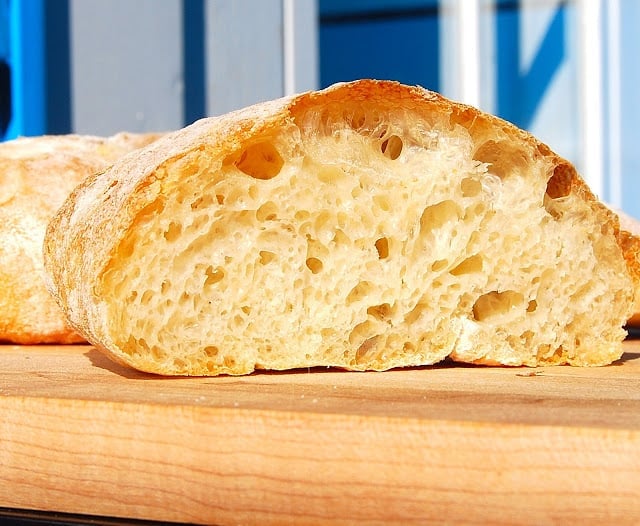
Recipe card
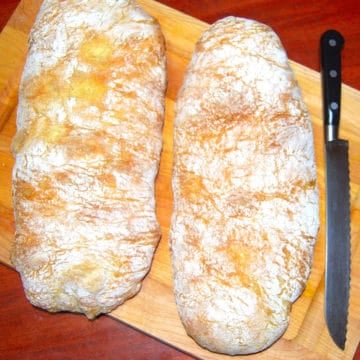
Quick Ciabatta
Ingredients
- 4 cups all-purpose flour
- 2 ¼ teaspoon active dry yeast
- 2 ¼ cups warm (not hot) water (you might need more if you are in a dryer area)
- 1 teaspoon salt
- ¼ teaspoon sugar (not usually found in traditional ciabatta, but it really helps speed the rise)
Instructions
- Mix the sugar, water and yeast in a bowl and set aside for five minutes for the yeast to start working.
- Add the flour and salt and mix in a stand mixer fitted with a paddle. You want the mixture to be just slightly thicker than a pancake batter-- it should definitely not pull together into a firm dough.
- Let the mixture stand for about 15 minutes. Then turn on the stand mixer to a medium-high setting. After about six minutes, the dough will start to make a flapping sound and start rising up the sides of the bowl.
- At this point, switch the paddle for the dough hook and knead for another six to seven minutes until the dough starts pulling cleanly off the sides of the bowl. It will be smooth at this stage but still very sticky and loose.
- Grease a bowl and pour the dough into it. Cover with a plastic wrap or kitchen towel and place in a warm spot, like an oven with the pilot light on.
- In about 1 ½ to 2 hours, the dough would have tripled.
- Prepare a cookie sheet by lining it with parchment paper and then dusting the paper liberally with flour.
- Pour the dough out of the bowl and into the center of the cookie sheet. Dust the top with flour.
- Using a bench scraper, divide the dough into two pieces. Using the bench scraper and a wet hand if needed, shape the dough, tucking the irregular pieces underneath, until you have two flat logs. The logs should be about six inches apart. This is a rustic bread, and the wet dough is not going to hold a definite shape, so don't even try for a beautiful, even look. This is known as an Italian slipper bread for a reason. The baked bread will turn out absolutely gorgeous, trust me, with a translucent, lit-from-within look and those gorgeous air holes.
- Dust some more flour over the logs, then cover them with a loose kitchen towel and place in a warm spot for about an hour or until the logs are risen and all puffy-looking.
- About half an hour before baking, preheat the oven to 500 degrees with a pizza stone or baking stone in place. Place an empty pan in the bottom rack while preheating, then add a cup of water to it just before you place the bread in the oven.
- Place the ciabatta loaves directly on the baking stone by sliding the parchment off your cookie sheet. If you are really not sure how to do this, just place the entire baking sheet on top of the baking stone.
- Bake for 25 minutes or until the loaves are golden-brown and the bottom sounds hollow then tapped.
- Cool thoroughly on a rack.
Nutrition Information
To print recipe card without images, uncheck "instruction images" after clicking the "print recipe" button.


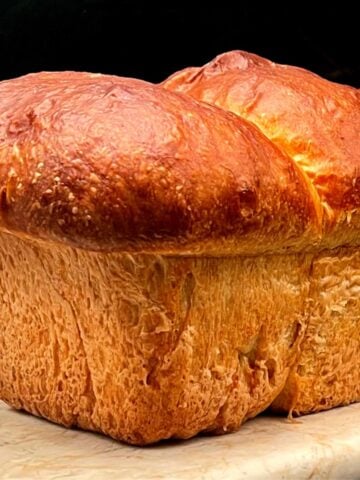
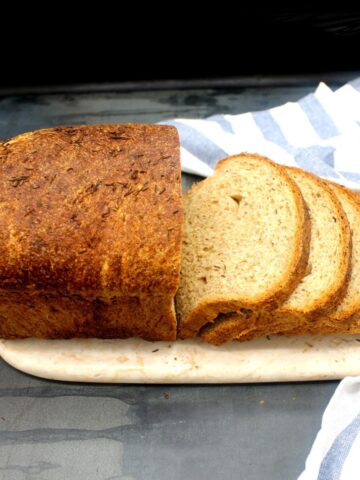
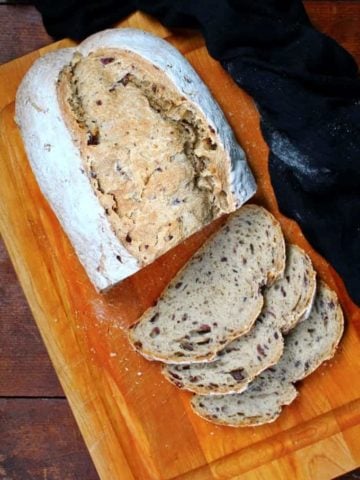
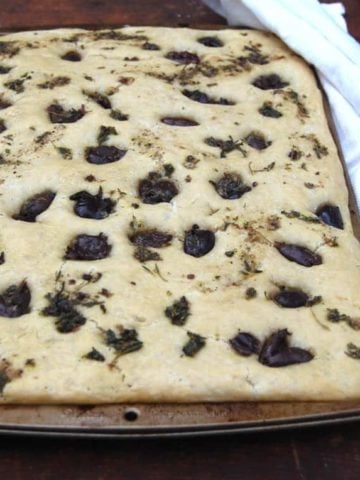




Diane Shaner says
I want to try this recipe but I don't have either a pizza stone or a baking stone. Will the Ciabatta bread still turn out if I just bake on a cookie sheet
Phil says
Can this be made using 50% ot 100% whole wheat flour?
Anonymous says
I love this bread, but the baking time for me is a lot less than 25 minutes, if I cooked it that long the crust would be way too hard and maybe burnt. Also have to adjust the flour because it's too wet at the specified ratios, but I've gotten some experience making the bread and I'm pretty good at judging the moisture content now. Wish there was some way other than fiddling and experience to get the right ratio but that's the way of the bread!
Bo says
as much i enjoy my homemade crusty bread i always dread the shaping part bc the experience can be pretty inconsistent due to wet dough. i always do it on my wooden pastry board and sometimes i have an easier time sometimes it just sends me into a rage bc STICKY! thanks to this recipe now i know i can actually just do it straight in the pan it was so easy!
1) when using the paddle i never saw dough climbing up the bowl
2) i overproofed it a lil bit but not a big deal
3) did i mention how easy and satisfying the shaping process was? it actually took no effort at all to make it look pretty
4) this makes 2 gigantic loaves that fit perfectly in a half sheet
Vaishali says
Hi Bo, thanks for the feedback and so happy you enjoyed the ciabatta. I love the shaping part too - freeform works for me lol.
Alice says
I used this as a guide to make ciabatta rolls for work when our baker wasn't able to supply rolls for our popular breakfast buns! I multiplied the recipe by 4 to make about 32 buns. Worked well! I baked them for 25 min which seemed to work even though they were smaller. 15 at 400F with fan on and water in bottom of tray, 10 at 350 with fan off and removed water. This baking strategy was suggested by another recipe. No idea if it was a good idea but the rolls turned out well 🙂